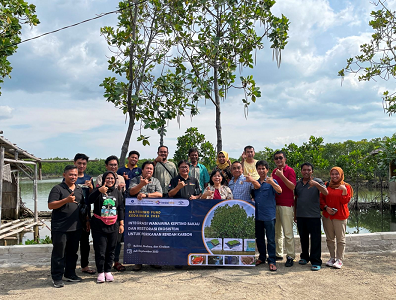Developing Mangrove Crab Wanamina, IPB University Together with Industry Partners Involve Fishermen and Coastal Communities of Bekasi and Brebes

IPB University in collaboration with PT Inovasi Teknologi Bangsa (Inoteb) launched a breakthrough called the Mangrove Crab Integration Program and Mangrove Ecosystem Restoration for Low Carbon Fisheries. This program is implemented through the Kedaireka Matching Fund scheme which supports collaboration between universities and industrial partners in dealing with environmental and sustainability challenges.
Field orientation activities were carried out in two coastal areas namely Muara Gembong, Bekasi and Kaliwangi, Brebes with the aim of developing a sustainable and environmentally friendly crab fishery. Its implementation also involves the community in efforts to transfer technology and knowledge, especially fishermen and coastal communities.
Prof Dietriech Bengen as the head of the research team revealed that this program was a step forward for IPB University and industrial partners in supporting sustainable development. This effort is also expected to provide benefits for coastal communities that depend on marine resources.
“Mangroves as crab habitat play an important role for the survival and breeding of mangrove crabs. It should be maintained to maintain the environmental and economic conditions of coastal communities,” said Prof Dietriech.
The average number of crabs collected on the coast of Muara Gembong can reach 100-150 kg per day and is still less when compared to market demand. Prices for crabs vary from IDR 150,000 for stuffed crabs to IDR 400,000 for egg crabs. Before being sold, crabs are taken from the wild and raised in ponds or ponds that have been partitioned off by bamboo. Crabs are raised within 3-4 weeks by feeding trash fish.
“The crab business is very promising. However, for the industrial scale, it is necessary to have a sustainable supply chain and quality control for crabs being marketed, especially for export needs,” continued Akhmad Syarbini, the Main Director of PT Inoteb, an industrial partner of the Matching Fund.
In Kaliwangi, crab business actors have adopted an intensive crab farming business using simple crab apartments made of bamboo in ponds or ponds surrounded by mangrove trees. The cultivation process involves using special boxes for each crab at 10-14 crabs per kilogram to ensure optimal rearing. Filling and harvesting of crabs are carried out regularly and alternately to maintain optimal stock availability of crabs in the pond.
Apart from ponds, some people use empty land by making tarpaulin ponds to raise crabs. Salinity and water circulation are maintained to maintain crab life during rearing. However, one of the drawbacks of this system is the high exposure to the sun in the area around the pond which increases algae growth, both in the pond and on the crab’s body. This is certainly not good for the cleanliness and health of the crabs that are raised.
“We really hope that there will be education and collaboration from researchers and also industry that can help the community in developing the crab industry in our village,” said Bangkit, the Chairman of Karang Taruna in Kaliwangi, Brebes.
As a continuation of the Matching Fund program, IPB University will develop a mini hatchery to provide crab seeds in a sustainable manner, reducing dependence on catching from nature.
In addition, internet-based digital technology will be used for the development of environmentally friendly alternative feeds, so that the water and carbon footprint of mud crab production can be minimized. These steps are concrete efforts to face the challenges of climate change and achieve sustainable development in the crab fisheries sector. (DEA/RAT/Rz) (IAAS/Res)



